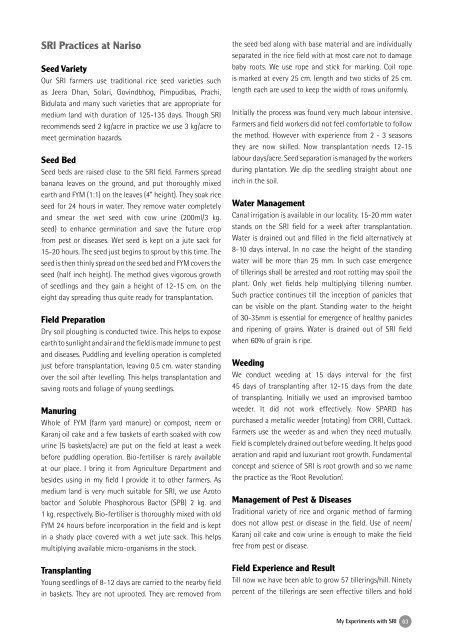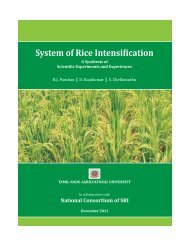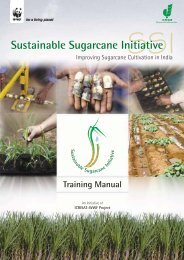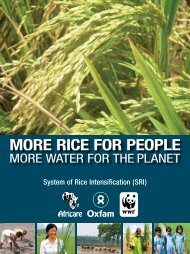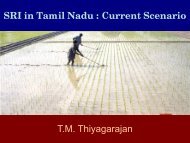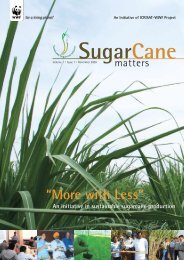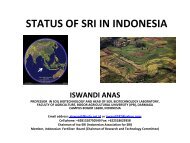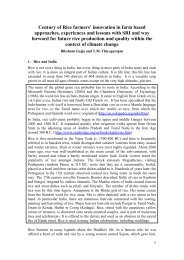SRI in Orissa - Cornell International Institute for Food, Agriculture ...
SRI in Orissa - Cornell International Institute for Food, Agriculture ...
SRI in Orissa - Cornell International Institute for Food, Agriculture ...
Create successful ePaper yourself
Turn your PDF publications into a flip-book with our unique Google optimized e-Paper software.
<strong>SRI</strong> Practices at Nariso<br />
Seed Variety<br />
Our <strong>SRI</strong> farmers use traditional rice seed varieties such<br />
as Jeera Dhan, Solari, Gov<strong>in</strong>dbhog, Pimpudibas, Prachi,<br />
Bidulata and many such varieties that are appropriate <strong>for</strong><br />
medium land with duration of 125-135 days. Though <strong>SRI</strong><br />
recommends seed 2 kg/acre <strong>in</strong> practice we use 3 kg/acre to<br />
meet germ<strong>in</strong>ation hazards.<br />
Seed Bed<br />
Seed beds are raised close to the <strong>SRI</strong> field. Farmers spread<br />
banana leaves on the ground, and put thoroughly mixed<br />
earth and FYM (1:1) on the leaves (4” height). They soak rice<br />
seed <strong>for</strong> 24 hours <strong>in</strong> water. They remove water completely<br />
and smear the wet seed with cow ur<strong>in</strong>e (200ml/3 kg.<br />
seed) to enhance germ<strong>in</strong>ation and save the future crop<br />
from pest or diseases. Wet seed is kept on a jute sack <strong>for</strong><br />
15-20 hours. The seed just beg<strong>in</strong>s to sprout by this time. The<br />
seed is then th<strong>in</strong>ly spread on the seed bed and FYM covers the<br />
seed (half <strong>in</strong>ch height). The method gives vigorous growth<br />
of seedl<strong>in</strong>gs and they ga<strong>in</strong> a height of 12-15 cm. on the<br />
eight day spread<strong>in</strong>g thus quite ready <strong>for</strong> transplantation.<br />
Field Preparation<br />
Dry soil plough<strong>in</strong>g is conducted twice. This helps to expose<br />
earth to sunlight and air and the field is made immune to pest<br />
and diseases. Puddl<strong>in</strong>g and levell<strong>in</strong>g operation is completed<br />
just be<strong>for</strong>e transplantation, leav<strong>in</strong>g 0.5 cm. water stand<strong>in</strong>g<br />
over the soil after levell<strong>in</strong>g. This helps transplantation and<br />
sav<strong>in</strong>g roots and foliage of young seedl<strong>in</strong>gs.<br />
Manur<strong>in</strong>g<br />
Whole of FYM (farm yard manure) or compost, neem or<br />
Karanj oil cake and a few baskets of earth soaked with cow<br />
ur<strong>in</strong>e (5 baskets/acre) are put on the field at least a week<br />
be<strong>for</strong>e puddl<strong>in</strong>g operation. Bio-fertiliser is rarely available<br />
at our place. I br<strong>in</strong>g it from <strong>Agriculture</strong> Department and<br />
besides us<strong>in</strong>g <strong>in</strong> my field I provide it to other farmers. As<br />
medium land is very much suitable <strong>for</strong> <strong>SRI</strong>, we use Azoto<br />
bactor and Soluble Phosphorous Bactor (SPB) 2 kg. and<br />
1 kg. respectively. Bio-fertiliser is thoroughly mixed with old<br />
FYM 24 hours be<strong>for</strong>e <strong>in</strong>corporation <strong>in</strong> the field and is kept<br />
<strong>in</strong> a shady place covered with a wet jute sack. This helps<br />
multiply<strong>in</strong>g available micro-organisms <strong>in</strong> the stock.<br />
Transplant<strong>in</strong>g<br />
Young seedl<strong>in</strong>gs of 8-12 days are carried to the nearby field<br />
<strong>in</strong> baskets. They are not uprooted. They are removed from<br />
the seed bed along with base material and are <strong>in</strong>dividually<br />
separated <strong>in</strong> the rice field with at most care not to damage<br />
baby roots. We use rope and stick <strong>for</strong> mark<strong>in</strong>g. Coil rope<br />
is marked at every 25 cm. length and two sticks of 25 cm.<br />
length each are used to keep the width of rows uni<strong>for</strong>mly.<br />
Initially the process was found very much labour <strong>in</strong>tensive.<br />
Farmers and field workers did not feel com<strong>for</strong>table to follow<br />
the method. However with experience from 2 - 3 seasons<br />
they are now skilled. Now transplantation needs 12-15<br />
labour days/acre. Seed separation is managed by the workers<br />
dur<strong>in</strong>g plantation. We dip the seedl<strong>in</strong>g straight about one<br />
<strong>in</strong>ch <strong>in</strong> the soil.<br />
Water Management<br />
Canal irrigation is available <strong>in</strong> our locality. 15-20 mm water<br />
stands on the <strong>SRI</strong> field <strong>for</strong> a week after transplantation.<br />
Water is dra<strong>in</strong>ed out and filled <strong>in</strong> the field alternatively at<br />
8-10 days <strong>in</strong>terval. In no case the height of the stand<strong>in</strong>g<br />
water will be more than 25 mm. In such case emergence<br />
of tiller<strong>in</strong>gs shall be arrested and root rott<strong>in</strong>g may spoil the<br />
plant. Only wet fields help multiply<strong>in</strong>g tiller<strong>in</strong>g number.<br />
Such practice cont<strong>in</strong>ues till the <strong>in</strong>ception of panicles that<br />
can be visible on the plant. Stand<strong>in</strong>g water to the height<br />
of 30-35mm is essential <strong>for</strong> emergence of healthy panicles<br />
and ripen<strong>in</strong>g of gra<strong>in</strong>s. Water is dra<strong>in</strong>ed out of <strong>SRI</strong> field<br />
when 60% of gra<strong>in</strong> is ripe.<br />
Weed<strong>in</strong>g<br />
We conduct weed<strong>in</strong>g at 15 days <strong>in</strong>terval <strong>for</strong> the first<br />
45 days of transplant<strong>in</strong>g after 12-15 days from the date<br />
of transplant<strong>in</strong>g. Initially we used an improvised bamboo<br />
weeder. It did not work effectively. Now SPARD has<br />
purchased a metallic weeder (rotat<strong>in</strong>g) from CRRI, Cuttack.<br />
Farmers use the weeder as and when they need mutually.<br />
Field is completely dra<strong>in</strong>ed out be<strong>for</strong>e weed<strong>in</strong>g. It helps good<br />
aeration and rapid and luxuriant root growth. Fundamental<br />
concept and science of <strong>SRI</strong> is root growth and so we name<br />
the practice as the ‘Root Revolution’.<br />
Management of Pest & Diseases<br />
Traditional variety of rice and organic method of farm<strong>in</strong>g<br />
does not allow pest or disease <strong>in</strong> the field. Use of neem/<br />
Karanj oil cake and cow ur<strong>in</strong>e is enough to make the field<br />
free from pest or disease.<br />
Field Experience and Result<br />
Till now we have been able to grow 57 tiller<strong>in</strong>gs/hill. N<strong>in</strong>ety<br />
percent of the tiller<strong>in</strong>gs are seen effective tillers and hold<br />
My Experiments with <strong>SRI</strong> 63


